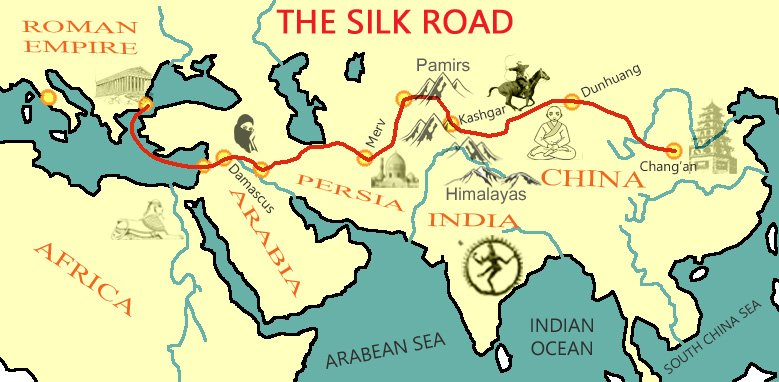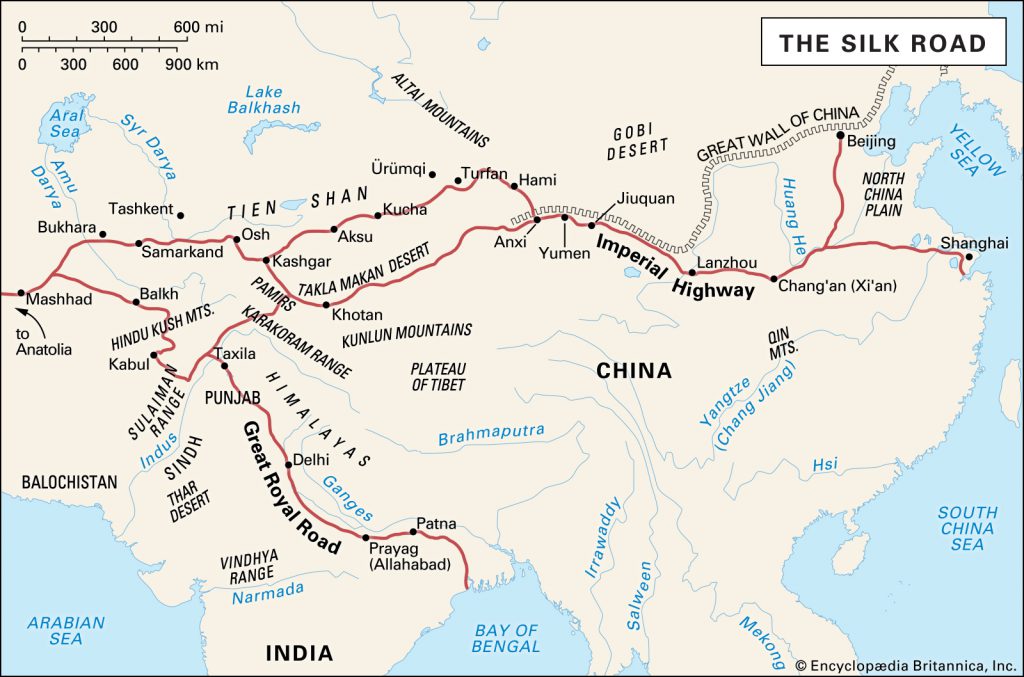

Xian
The capital of ancient imperial China. It was from Xi’an that the first emperor of China, Qin Shi Huang.
“At the height of its glory in the mid-eighth century, Chang’an was the most populous, cosmopolitan, and civilised city in the world”
Dunhuang
Chinese traders leaving for the west would have had to cross the vast Gobi desert. Dunhuang was an oasis town built on the edge of this desert; sustained by the Cresent Lake and flanked on all sides by sand dunes.
Grateful travellers would have been provided food, water and shelter here before setting off on their journey.
The nearby Mogao Caves are a UNESCO World Heritage site, made up of 735 caves cut into the rock by Buddhist monks over a period of 1,000 years.
The name Dunhuang means “Blazing beacon” and refers to its vital importance for warning of incoming raids from Central Asia into the heart of China.
Samarkan
An amazing city at the heart of Central Asia.. an important city on the Silk Roads strategically located between China and the Mediterranean.
Aleppo
Strategically situated between the eastern mediterranean cost and the Euphrates Valley at the crossroads of several trade routes since the 2nd millennium B.C., Aleppo stands out as one of the key centers along the legendary Silk Roads.
Mosul
Once a fourishing industrial and commercial city, Mosul, in today’s Northern Iraq and the north’s major center for trade, industry and communications, was once a thriving city on the Silk Roads.
Kashgar
Merv
Situated by an oasis in modern day Turkmenistan, Merv was conquered by a succession of empires that tried to control the centre of the Silk Road.
Described by a 10th century geographer as the “mother of the world,” Merv reached its height in the early 13th century when it was the largest city in the world, with over 500,000 people.
In one of the bloodiest episodes in Central Asian history, the city fell to the Mongols in 1221 and Gengis Khan’s son ordered the massacring of the entire population inside.
Merv, was a major oasis-city in Central Asia, on the historical Silk Road, located near today’s Mary in Turkmenistan. In the early Islamic period, Merv was the capital of the province of Khorasan, and in the 12th century it was the largest city in the world.
Damascus
Damascus has a rich history dating back 11,000 years and has been continuously inhabited for over four millennia.
It lies at a crucial crossroads of two trade routes: a north-south route from Constantinople to Egypt, and an east-south route connecting Lebanon with the rest of the Silk Road.
Chinese silks passed through Damascus on their way to western markets. Its crucial importance in this respect is illustrated by the introduction of the word “damask” into the English language as a synonym for silk.
Constantinople
Although the Western Roman Empire fell to waves of barbarian migrations in the 4th and 5th century, the Eastern Roman Empire survived right through the Middle Ages, up until 1453. The capital of the Eastern Roman Empire was Constantinople.
The wealth of this magnificent capital was legendary, and luxury goods from China and India made their way across the length of Asia to be sold in its markets.
Constantinople represents the end of the Silk Road. All roads still led to Rome, but the new Rome sat on the banks of the Bosphorus.
The single most important city on the Silk Road was its final terminus: Istanbul (Constantinople). It was here that traders wound up their westward journey before their goods were spirited deeper into Europe, to the marketplaces of Venice and Rome.
From the 4th century onwards, all ancient roads led to Constantinople. Almost everything you see in Turkey’s capital today has some connection to that time of great financial and intellectual prosperity, when the city profited from its prime location on the cusp of two continents. Christianity emanated from the cloisters of the 6th century Hagia Sophia and started its march east with Constantinople as its origin point. The Bosphorus Straight took on its persona as a lively hub for sea trade.
When it fell to the Ottomans in 1453, the city’s name was changed, but its new rulers made sure its reputation as a trading centre was still cultivated. The Grand Bazaar was established to centralise goods and still dominates Istanbul’s centre to this day.